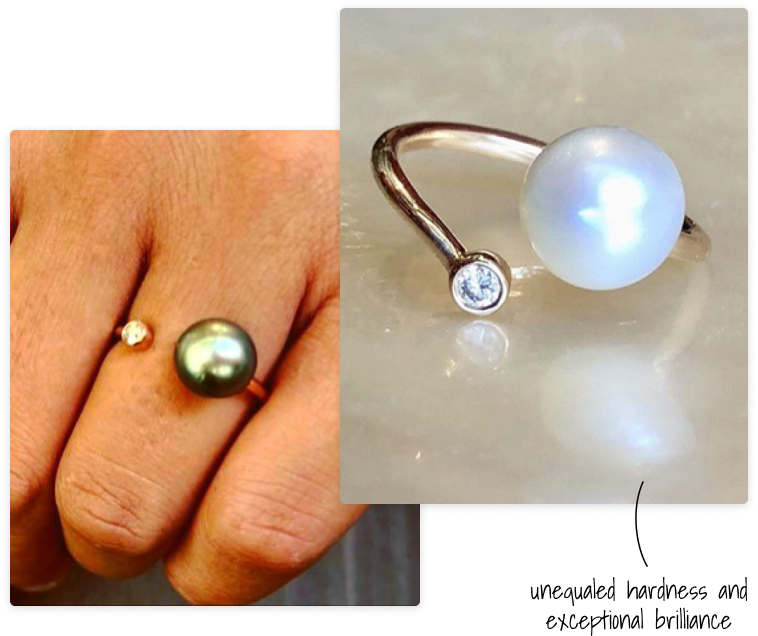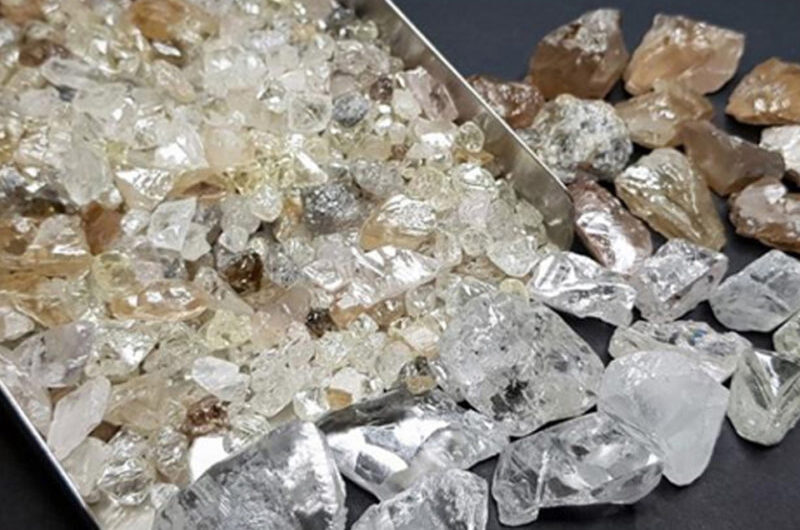You've added...
Diamond

WHAT IS ITS ETYMOLOGICAL ORIGIN?
When thinking of diamond, words that often come to mind are “eternity,” “purity,” and “invincibility.” However, the etymological origin of the word “diamond” is as fascinating as the stone itself. The term “diamond” comes from the ancient Greek word “adámas,” meaning “indomitable” or “invincible,” a direct reference to the exceptional hardness of this gem, the highest of all natural stones.
Beyond its Greek name, diamond has been known and celebrated in many cultures throughout history, each attributing different names and meanings to it, often related to its qualities of purity and hardness. For example, in Sanskrit, diamond is called “vajra,” which also means “thunderbolt” – another nod to its strength and durability.
Read more
The history of the diamond
However, the discovery of diamonds in South Africa in the 1870s revolutionized the industry. The discovery of the Kimberley diamond deposit not only marked the beginning of large-scale diamond production but also led to the creation of De Beers, a company that would dominate the global diamond market for many years. Over the centuries, diamonds have crossed various cultures, holding a place of honor among royalty and high society. From the admiration of ancient people for its rarity and beauty to its central role in the modern world of jewelry and fashion, the diamond continues to fascinate, symbolizing wealth, power, and eternal love.
A myth about the diamond
CHARACTERISTICS:
- Mineral Group: Diamond is a form of crystallized carbon, belonging to the group of native minerals.
- Chemical Composition: Its chemical formula is simple: C, indicating that it is composed entirely of carbon. What makes the diamond unique is the arrangement of these carbon atoms, forming a cubic crystal structure, giving diamond its unmatched hardness.
- Crystal System: Cubic, characterized by square faces and high symmetry, contributing to its durability and brilliance.
- Hardness: Diamond is the hardest known mineral, with a hardness of 10 on the Mohs scale, allowing it to scratch all other minerals.
- Inclusions: While pure diamonds are highly sought after, inclusions, such as crystals of other minerals or internal imperfections, can be present. These characteristics, while decreasing a diamond's value, can also add to its unique character and trace its geological history.
Main diamond deposits
African deposits, particularly in South Africa, Botswana, Angola, and the Democratic Republic of the Congo, are among the most prolific. The Kimberley mine in South Africa, discovered in the 19th century, was one of the first to be industrially mined, marking a key milestone in diamond history.
Besides Africa, Russia is a major player, with mines like Mirny in Siberia, known for its extreme conditions and abundant production. Canada is also a significant producer, with deposits such as Diavik and Ekati in the Northwest Territories, valued for their ethical and eco-friendly practices.
How are diamonds extracted ?
Marine mining is another method, primarily used off the African coast. In this method, diamonds are extracted from the seabed, where they were transported by rivers millions of years ago.
Each extraction method presents unique challenges, particularly regarding environmental impact and worker safety. Additionally, diamond extraction is often associated with ethical concerns, especially in conflict regions. This has led to the implementation of certification processes, such as the Kimberley Process, designed to ensure that traded diamonds do not fund armed conflicts.
Zoom on diamond formation !
This metamorphosis occurs over extremely long periods, often spanning millions or even billions of years. Diamonds are then transported to the Earth’s surface by volcanic eruptions, encapsulated in magmatic rocks like kimberlite or lamproite. These eruptions create geological structures known as kimberlite pipes, which are the primary sources of diamonds.
The color of diamonds varies based on impurities present during their formation. For example, nitrogen can impart yellow hues, while boron can create blue diamonds. Most diamonds, however, range from colorless to slightly yellow or brown. A diamond's quality is assessed based on the “Four Cs” criteria: Carat (weight), Clarity (purity), Color, and Cut.
Properties of natural diamonds
Interesting Anecdote: Many cultures and civilizations have attributed mystical powers to diamonds. For example, in some Hindu beliefs, diamonds were thought to protect their wearer from evil. These beliefs, though unscientific, form an integral part of the cultural and symbolic heritage surrounding these extraordinary gems.
PHYSICAL BENEFITS AND VIRTUES
Diamonds have the ability to strengthen the body and mind. They act as a tonic for the entire body and are also beneficial for vision, balance, and metabolism, helping to cleanse the body and mind of toxins and negativity.
PSYCHIC BENEFITS AND VIRTUES
On a psychic and emotional level, diamonds are often associated with clarity of thought, enlightenment, and spiritual openness. They are believed to promote self-confidence, determination, and independence while helping to overcome anxiety and fear. In some traditions, diamonds are considered a symbol of courage and victory, helping individuals stay resolute and centered in challenging situations.
Diamonds are also reputed to enhance interpersonal relationships, fostering love, commitment, and loyalty. They are believed to clarify thoughts and feelings, aiding in more open and honest communication. Finally, on a spiritual level, diamonds are often seen as manifestation stones, helping to realize intentions and desires. They are said to elevate the spirit, foster creativity, and inspire a sense of abundance and fulfillment.
ASTROLOGY
For astrology enthusiasts, diamonds are often associated with certain zodiac signs, particularly Aries and Leo. However, due to their purity and brilliance, they are considered universal stones that can complement all signs. Diamonds are thought to bring strength, courage, and clarity to those who wear them, qualities that resonate with Aries and Leo, known for their dynamism and leadership.
Diamonds are often chosen to symbolize significant life moments, such as engagements, weddings, or anniversaries. They are seen as symbols of eternal love, devotion, and recognition, making each piece of diamond jewelry not only beautiful but also imbued with meaning.

